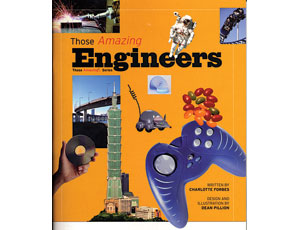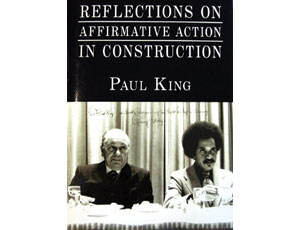 | Those Amazing Engineers Second edition, updated by Charlotte Forbes 30 pages; $10.95-$15, with special pricing for bulk orders and the Adopt-A-School program (Trilogy Publications, 2010) Those engineers, they continue to amaze! So, this update of a 2004 primer on the profession, geared toward older elementary and middle-school students, reflects not only new engineering records and niches but also offers incentives to boost its appeal to kids, teachers, parents and corporate sponsors. The book, which explains what practitioners do in key engineering specialties, has not changed much in presentation, with mostly the same vibrant visuals and kid-friendly text. About 70,000 copies of the first edition, sponsored by the New York chapter of the American Council of Engineering Companies, are now in print. Revisions to the book include Taiwan’s Taipei 101 skyscraper replacing Kuala Lumpur’s shorter Petronas Towers on the cover as well as new space devoted to overviews of two disciplines whose appeal is growing among younger generations: environmental engineering and software engineering. Also new is publisher Trilogy’s push to more link corporate sponsors and school officials through its “Adopt-A-School” program, which matches schools requesting books with companies and associations that will provide copies and a teacher’s guide at no charge. In a pilot effort, consultant Weidlinger Associates, New York City, provided 400 gratis copies to a school in Worcester, Mass., says the publisher, which adds that it has already received more than 6,500 book requests for schools, summer camps and special programs in 31 states. An effort to distribute “Those Amazing Engineers” in New York City schools begins this month, with funding from engineers Halcrow and Thornton Tomasetti. Trilogy’s series, which includes “Those Amazing Scientists,” soon will feature the “Those Amazing Builders,” which will focus on project managers, contractors and construction trades. The book’s advisory committee is bullish on the possibilities. “It is exciting to imagine the future of our profession,” says Mysore Nagaraja, a New York City-based engineering consultant and former president of the Metropolitan Transportation Authority’s capital construction unit. Adds Michael Della Rocca, president of Halcrow North America, “If we can show children the marvels of everyday things they take for granted and link that knowledge to the engineering profession, we increase the chance that a motivated and talented young person will travel down the path.” |

| Reflections on Affirmative Action In Construction 271 pages; $25.99 (AuthorHouse, 2009) More than 40 years ago, construction sites in Chicago were 98% white. Today, the number of blacks and other minorities in the trades is well over 20%. Contracts set aside for minority participation are now commonplace, yet few minority professionals own businesses large enough to compete with old-line construction firms run largely by white men. This greatly troubles Paul King, a former painting contractor who, in 1969, helped lead the affirmative-action movement in the construction business. With the support of Chicago street gangs (who look like Boy Scouts compared to modern thugs), King and other affirmative-action leaders earned a place at the bargaining table by shutting down jobsites, demanding equal rights and helped enact laws. Along with the fight, King, now 70, learned how much of a personal struggle the construction business can be. As the founder and chairman of contractor UBM Inc., King was cited by ENR as early as 1974 for his efforts. His firm eventually grew to more than 100 employees and an annual revenue of roughly $50 million; by 2004, it was the largest black-owned general contractor in Illinois. The firm won several design awards, and King was elected to the National Association of Minority Contractors’ Hall of Fame. But, by 2007, UBM had folded under economic pressure—non-payment by public agencies, he says. More than a memoir, the book is a rich collection of letters, photos and articles by various writers that tells the industry’s affirmative-action story. In a way, this structure reflects construction’s dynamic, diverse nature. This inspiring story, however, leaves the reader wondering if affirmative action still works. “Today, there are more ‘minorities’ in the unions, but the number of African-Americans is often less than other ethnic groups and white women,” says the author. Such factors as poor recruiting, system abuses, slow pay increases, white-firm lobbying and a general loss of public support have all hurt affirmative action, according to King. In the end, though, he chalks up much of the remaining challenge to a lack of activism within the black community and a “digital divide” that threatens to keep poor, minority children from discovering how exciting and profitable a career in construction can be. |

Post a comment to this article
Report Abusive Comment